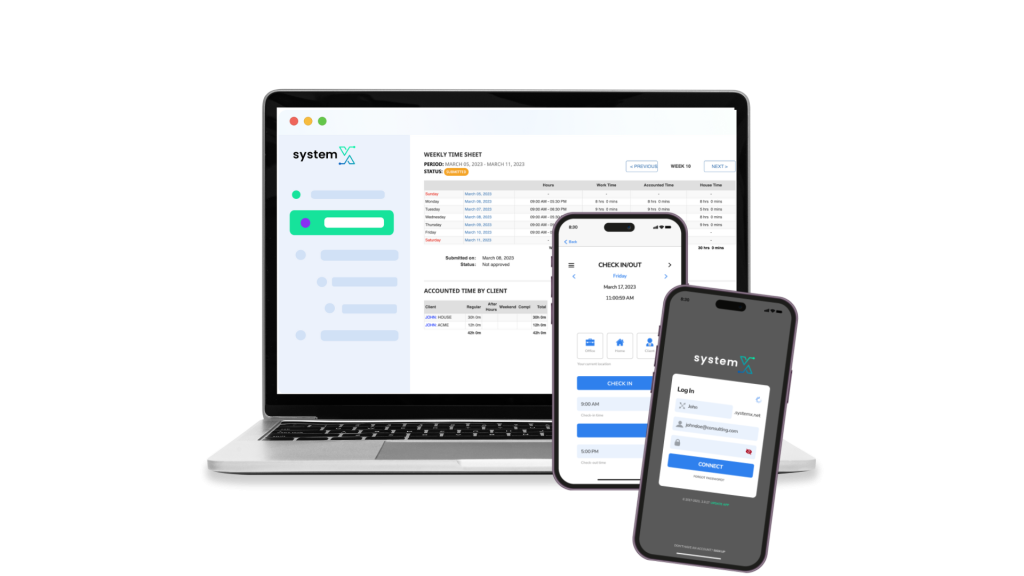Choosing the right tool for business management in today’s dynamic environment can be a challenge with the array of platforms available. Amidst the crowd, HoneyBook and SystemX stand out, each catering to different professional needs. HoneyBook is designed for independent businesses, while SystemX is a comprehensive solution for various professionals.
In this article, we’ll unpack the features, pros, and cons of both platforms to guide your decision-making process for the perfect fit for your needs.
What is Honeybook
HoneyBook is a streamlined platform designed to support independent businesses manage their operations more efficiently. It provides an array of features that enable businesses to book clients, manage projects, and streamline payments, all in one place.

What is SystemX
SystemX is a business management platform designed specifically for consultants, entrepreneurs, contractors, and start-ups. It provides a comprehensive suite of tools to manage various aspects of a business.

Comparing Key Features
Expense Tracking
Honeybook offers simplicity and speed, ideal for entry-level solo consultants, although it lacks some advanced features like receipt uploads, auto-adding expenses to invoices, client auto-expensing, automatic tax calculations, and bulk expense addition.
On the other hand, SystemX delivers detailed expense reports, supports receipt uploads, expense type customization, and bulk expense addition to reports. It also allows easy billing of expenses to customers, but its extensive functionality might be overwhelming for new users.
Honeybook
Pros
- User-friendly: Simple and fast to use.
- Provides essential features for entry-level solo consultants.
Cons
- Lack of advanced features: Unable to upload receipts.
- Limited invoicing and purchase order capabilities: Expenses cannot be auto-added.
- Tax calculation: Does not include automatic tax calculations.
- Manual process: Expenses must be added individually to a report, with no bulk add feature.
SystemX
Pros
- Detailed Reports: Offers straightforward, thorough expense reports.
- Receipt Management: Allows for receipt uploads, ensuring proper record keeping.
- Customization: Provides the ability to customize expense types.
- Multi-Expense Reporting: Can add multiple expenses in a single report.
- Client Billing: Expenses can be easily added to invoices and billed to customers.
Cons
- Time-Consuming: More detailed process could be time-consuming.
- Complexity: May be overwhelming for new consultants due to its comprehensive functionality.
Invoicing
Honeybook offers a simplified and user-friendly invoicing solution ideal for solo consultants. It features drag-and-drop invoicing, customizable designs, and the ability to create invoices directly from tracked time, amongst other features. However, it lacks advanced features such as line item discounting and adding official expense items. Conversely, SystemX provides a more comprehensive invoicing solution suitable for larger teams. It offers multiple invoice presentations, line item discounting, and integrated addition of purchase order items, expenses, and timesheets. However, its detail-oriented approach might prove overwhelming for some users.
Honeybook
Pros
- User-Friendly: Drag-and-drop invoicing for simplicity.
- Customizable: Adaptable designs to match your company style.
- Streamlined: Service catalog for faster and easier invoicing.
- Comprehensive: Native payment processor, and editable invoice and payment page.
- Dynamic: Can create invoices directly from tracked time and add extra details such as videos, images, questionnaires, etc.
Cons
- Lack of Features: No line item discounting or addition of official expense item.
- Limited Flexibility: Invoices conform to a fixed template model.
SystemX
Pros
- Versatility: Offers multiple invoice presentation options.
- Comprehensive: Detailed approach to invoicing with line item discounting.
- Integrated: Easily add purchase order items, expenses, timesheets, etc.
Cons
- Complexity: The level of detail can be overwhelming.
- Team-Oriented: Designed with larger teams in mind.
Project Management
Honeybook and SystemX both offer basic project management features, including the ability to quickly update clients, manage project and task lists, and assign projects to specific clients. Honeybook, however, provides a social media-like portal for continuous client interaction and allows project assignment to associates. Yet, it lacks depth in project management functionalities. On the contrary, SystemX offers detailed project tracking through milestones and completion percentages, but clients do not have access to the internal database.
Honeybook
Pros
- Quick Updates: Allows prompt client updates.
- Fundamental Features: Basic project and task list functionality.
- Delegation: Capable of assigning projects to associates or specific clients.
- Project Tracking: Ability to track various stages of projects.
- Client Portal: Social media-like portal for continuous client updates.
Cons
- Limited Functionality: Lacks depth in project management features.
SystemX
Pros
- Quick Updates: Provides rapid client updates.
- Project and Task Management: Basic project management and task list functionality.
- Delegation: Assign projects to specific clients.
- Detailed Tracking: Tracks stages of projects via milestones and completion percentages.
Cons
- Limited Client Access: Clients do not have access to the internal database.
Time Tracking
In terms of time tracking, Honeybook offers a basic time tracking solution which is simple to use and can directly be added to invoices. It also features an extension for time tracking on Chrome and a mobile app. However, it lacks detail and doesn’t include a timesheet feature. SystemX, on the other hand, provides a more detailed time management system suitable for larger teams, including a check-in/check-out feature, the ability to attribute time to specific projects, and easy addition of timesheets to invoices. However, it lacks a real-time tracking clock and doesn’t support time tracking on its web app.
Honeybook
Pros
- Easy to Use: Simple to add time used and directly integrate into invoices.
- Versatile: Offers a browser extension for time tracking in Chrome and a mobile app.
Cons
- Limited Detail: Time tracking lacks detailed features.
- Lack of Timesheets: Does not offer a timesheet feature.
SystemX:
Pros
- Comprehensive: Check-in and check-out features for precise time logging.
- Project-Specific: Attribute time spent to specific projects.
- Integration: Easily add timesheets to invoices.
- Remote Work Friendly: Allows specification of home-based work.
Cons
- Lack of Time Clock: No feature for tracking time in real-time.
- Platform Limitation: No time tracking on the web app.
CRM
In terms of CRM, Honeybook provides a simple solution that includes basic features such as adding client information, sales stage tracking, customer communication, and document organization. However, it may not scale well with teams larger than three members. SystemX, on the other hand, is better equipped for larger teams with detailed customer information tracking and file organization. However, it lacks features for tracking customer touchpoints and could be overwhelming due to its comprehensive functionalities.
Honeybook:
Pros
- Client Information: Ability to add client contact details.
- Sales Tracking: Features for updating stages of sales tracking.
- Communication: Facilitates easy communication with customers.
- Organization: Helps keep files, signed documents, and important material organized.
Cons
- Scaling Limitations: Not ideal for larger teams (3+ employees).
SystemX
Pros
- Comprehensive Contact Information: Detailed customer contact information and address book.
- Organization: Assists in keeping files organized.
- Scalability: Suitable for larger teams (3+ employees).
Cons
- Lacking Interaction Tracking: Features for tracking customer touchpoints are absent.
- Complexity: Can be overwhelming due to detailed features.
Additional Features
While we only compared the most popular features of these software, these app offer plenty more in functionality which we will touch upon here
SystemX
- Electronic signatures
- Quotes generation
- Address book
- Analytics and reports
- Bookings
- Sales orders
For a full list of SystemX visit our features page
Honeybook
- Template gallery
- Reports
- Automations
- One click integrations
- Leads forms
For a full list of honeybook features visit their features page
Conclusion
Both Honeybook and SystemX offer solutions tailored to various business needs. Honeybook provides a user-friendly interface, making it a great choice for solo consultants or small teams. On the other hand, SystemX offers a full suite of features that caters to businesses of all sizes, making it a powerful tool for managing your backend regardless of team size.
For an in-depth experience of what SystemX can do for your business, consider taking advantage of their 14-day free trial.

